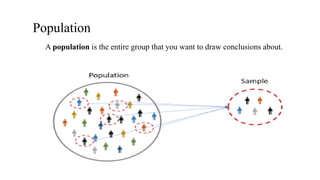
Population_ sample and hypothesis.pdf
- 1. Population A population is the entire group that you want to draw conclusions about.
- 2. Sample • In research terms a sample is a group of people, objects, or items that are taken from a larger population for measurement. The sample should be representative of the population to ensure that we can generalise the findings from the research sample to the population as a whole. • A sample is the specific group that you will collect data from. The size of the sample is always less than the total size of the population. • In research, a population doesn’t always refer to people. It can mean a group containing elements of anything you want to study, such as objects, events, organizations, countries, species, organisms, etc.
- 3. Hypothesis • A hypothesis is a tentative answer to a research problem that is advanced so that it can be tested. • A hypothesis may be precisely defined as a tentative proposition suggested as a solution to a problem or as an explanation of some phenomenon (Ary, Jacobs and Razavieh, 1984). ... Hypothesis is a tentative explanation that accounts for a set of facts and can be tested by further investigation.
- 4. .A hypothesis (plural hypotheses) is a precise, testable statement of what the researcher(s) predict will be the outcome of the study. It is stated at the start of the study. • A hypothesis is an assumption that is made based on some evidence. This is the initial point of any investigation that translates the research questions into predictions. It includes components like variables, population and the relation between the variables. A research hypothesis is a hypothesis that is used to test the relationship between two or more variables.
- 5. This usually involves proposing a possible relationship between two variables: the independent variable (what the researcher changes) and the dependent variable (what the research measures). • In research, there is a convention that the hypothesis is written in two forms, the null hypothesis, and the alternative hypothesis (called the experimental hypothesis when the method of investigation is an experiment).
- 6. A fundamental requirement of a hypothesis is that is can be tested against reality, and can then be supported or rejected. • To test a hypothesis the researcher first assumes that there is no difference between populations from which they are taken. This is known as the null hypothesis. The research hypothesis is often called the alternative hypothesis.
- 7. Types of research hypotheses 1) Alternative Hypothesis The alternative hypothesis states that there is a relationship between the two variables being studied (one variable has an effect on the other). An experimental hypothesis predicts what change(s) will take place in the dependent variable when the independent variable is manipulated. It states that the results are not due to chance and that they are significant in terms of supporting the theory being investigated.
- 8. 2) Null Hypothesis • The null hypothesis states that there is no relationship between the two variables being studied (one variable does not affect the other). There will be no changes in the dependent variable due to the manipulation of the independent variable. • It states results are due to chance and are not significant in terms of supporting the idea being investigated.
- 9. 3) Nondirectional Hypothesis • A non-directional (two-tailed) hypothesis predicts that the independent variable will have an effect on the dependent variable, but the direction of the effect is not specified. It just states that there will be a difference. • E.g., there will be a difference in how many numbers are correctly recalled by children and adults.
- 10. 4) Directional Hypothesis • A directional (one-tailed) hypothesis predicts the nature of the effect of the independent variable on the dependent variable. It predicts in which direction the change will take place. (i.e. greater, smaller, less, more) • E.g., adults will correctly recall more words than children.